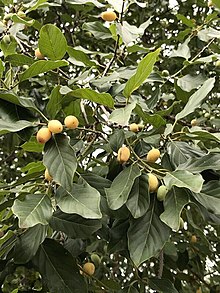| Phyllogeiton discolor | |
|---|---|

| |

| |
| Brown ivory in the Kruger National Park | |
| Conservation status | |
 Least Concern (IUCN 3.1) | |
| Scientific classification | |
| Kingdom: | Plantae |
| Clade: | Tracheophytes |
| Clade: | Angiosperms |
| Clade: | Eudicots |
| Clade: | Rosids |
| Order: | Rosales |
| Family: | Rhamnaceae |
| Genus: | Phyllogeiton |
| Species: | P. discolor |
| Binomial name | |
| Phyllogeiton discolor (Klotzsch) Herzog | |

| |
| Synonyms | |
List
| |
Phyllogeiton discolor (syn. Berchemia discolor), known as bird plum or brown ivory in English, is a tree native to southern and eastern Africa including Madagascar. It is a broadleaf tree growing to 18 m (60 ft).
The fruits, resembling dates, are edible with sweet flesh surrounding 1-2 flat seeds. They are occasionally sold in local markets, eaten fresh, or dried and pounded and then added to pearl millet pap for their sweet flavour. Animals such as monkeys, baboons and birds also eat them.
Ecology
The leaves are eaten by elephants, giraffe and several antelopes, as well as livestock, such that many trees exhibit a distinct browse line. The wood is hard and attractive, suitable for furniture, charcoal, building material, beehives, crafts, and things like tool handles and pestles.
Uses
Phyllogeiton discolor is also used as a dye, fodder, ornamental tree and as herbal medicine to treat several human and animal diseases and ailments. For instance, the Himba people cook the bark against nausea and diarrhoea.
Gallery
References
- Botanic Gardens Conservation International (BGCI) & IUCN SSC Global Tree Specialist Group. 2019. Berchemia discolor. The IUCN Red List of Threatened Species 2019: e.T146205371A146205373. https://dx.doi.org/10.2305/IUCN.UK.2019-2.RLTS.T146205371A146205373.en. Accessed 9 September 2022.
- ^ "Phyllogeiton discolor (Klotzsch) Herzog". Plants of the World Online. Board of Trustees of the Royal Botanic Gardens, Kew. 2017. Retrieved 10 September 2022.
- ^ Ruffo, Christopher K.; Birnie, Ann; Tengnäs, Bo (2002). Edible wild plants of Tanzania. Regional Land Management Unit/Sida. ISBN 9966-896-62-7.
- ^ "Meet the trees of Namibia ... The Bird Plum (Berchemia discolor)". The Namibian. 21 January 2016.
- "Berchemia discolor". PlantZAfrica.
- ^ Cheikhyoussef, Ahmad; Maroyi, Alfred (2017). "Bird Plum; Berchemia discolor (Klotzsch) Hemsl.: A Review of Its Ethnobotany, Phytochemistry and Pharmacology". Medicinal and Aromatic Plants of the World - Africa Volume 3. Vol. 3. pp. 143–155. doi:10.1007/978-94-024-1120-1_7. ISBN 978-94-024-1119-5.
| Taxon identifiers | |
|---|---|
| Phyllogeiton discolor | |
| Berchemia discolor |
|
| Scutia discolor | |
This Rhamnaceae article is a stub. You can help Misplaced Pages by expanding it. |
This fruit-related article is a stub. You can help Misplaced Pages by expanding it. |
This fruit tree-related article is a stub. You can help Misplaced Pages by expanding it. |
This Africa-related article is a stub. You can help Misplaced Pages by expanding it. |
- IUCN Red List least concern species
- Rhamnaceae
- Flora of Angola
- Flora of Ethiopia
- Flora of Madagascar
- Flora of Namibia
- Flora of Somalia
- Flora of the Northern Provinces
- Flora of Africa
- Flora of Tanzania
- Flora of Yemen
- Fruits originating in Africa
- Tropical fruit
- Plants described in 1868
- Flora of the Madagascar dry deciduous forests
- Rhamnaceae stubs
- Fruit stubs
- Fruit tree stubs
- Africa stubs


